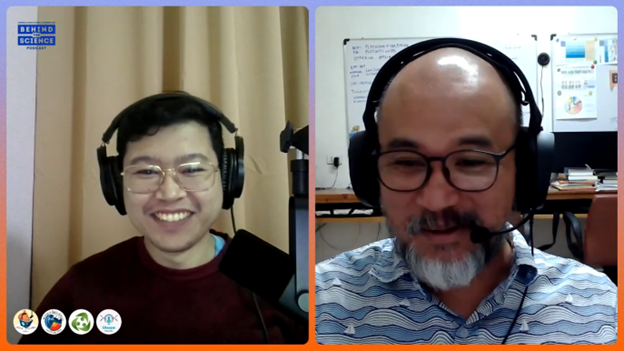In Episode 57 of the Behind the Science Podcast, environmental scientist Raymond Rodolfo, M.Sc., brings to light an often overlooked but crucial component of our coastal environments: submarine groundwater discharge (SGD). Through his work on underwater hot springs in Mabini, Batangas, Rodolfo explores how unseen natural processes beneath the seafloor play an outsized role in shaping marine ecosystems and influencing coastal hazard dynamics.
Mr. Rodolfo’s path to environmental science was grounded in a fascination with the Earth’s hidden systems and their intersections with human life. His academic training in environmental science at Ateneo de Manila University eventually led him to pursue fieldwork in coastal geology and hydrology. It was during a research dive in Mabini—a well-known dive tourism hub in Batangas—that he noticed continuous bubbling on the seafloor. What looked like a natural curiosity turned out to be a geological phenomenon: submarine hot springs quietly releasing gas and groundwater into the ocean.

His study employed field sampling, thermal imaging, and water chemistry analysis to verify the presence of SGD. What Rodolfo and his team found was compelling—these underwater discharges were altering local water temperature and pH and likely influencing marine biodiversity. These findings are not just of academic interest; they pose vital implications for how we manage coastal areas, particularly in regions like the Philippines where communities rely heavily on the health of marine ecosystems.
But Mr. Rodolfo’s work doesn’t stop at ecological impacts. He draws attention to the broader implications of SGD on disaster risk and environmental resilience. For example, when groundwater naturally escapes into the sea, it can contribute to gradual land subsidence—a pressing issue in urban coastal areas like Metro Manila. Furthermore, SGD sites may exacerbate vulnerability to coastal hazards if left unmonitored or misunderstood. These complexities, he argues, make a strong case for integrating local geological knowledge into national resilience and development planning.
In his conversation with the Dr. Paul Flores, Mr. Rodolfo reflects on the role of researchers in bridging science and society. He urges young scientists to engage in field-based, interdisciplinary research and to focus on projects that generate real-world impact. “You don’t need to wait decades for your work to matter,” he says. “Good science, especially in the environmental and disaster sciences, can save lives now.”
The episode offers a deep dive into how localized, data-driven studies can illuminate new frontiers in both science and disaster risk management. From gas bubbles on the seafloor to their links with climate resilience, Mr. Rodolfo’s research underscores the importance of looking below the surface—literally and figuratively—to understand the full picture of our environmental risks.
🎧 Listen to the episode:
- YouTube: bit.ly/btspodcast-yt
- Spotify: bit.ly/btspodcast-spotify
- Facebook: https://bit.ly/btspodcast-fb
📚 Research spotlight:
Rodolfo, R. (2023). Submarine Groundwater Discharge and Its Environmental Impacts in Mabini, Batangas. Journal of Marine Environmental Research, 78(2), 123-135.
